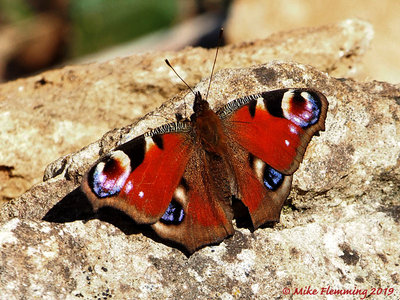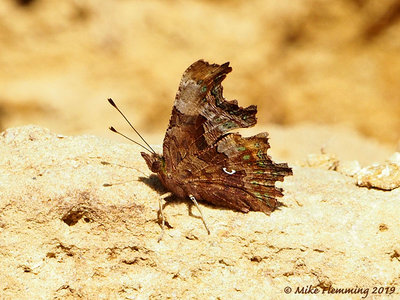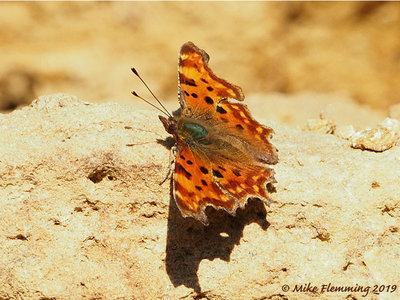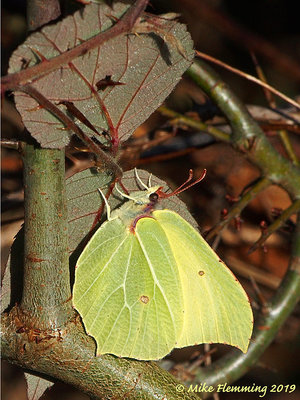Page 3 of 5
Re: February 2019
Posted: Sat Feb 23, 2019 11:23 pm
by David M
This is quite a unique February. I've never known one like it in my lifetime.
Fingers crossed we don't see a degeneration in weather conditions as such a development could prove damaging.
I wonder when Whites, Specklies and Holly Blues will emerge if this mild spell continues?
Re: February 2019
Posted: Sun Feb 24, 2019 3:38 am
by aeshna5
I had a 3 second glimpse of a white yesterday at Kew but disappeared from sight so no positive ID. Otherwise just a male Brimstone.
Re: February 2019
Posted: Sun Feb 24, 2019 9:38 am
by peterc
My first butterflies of the year yesterday near home at Roebuck Woodland, Stevenage. At least 2 male Brimstones one of which kindly obliged and posed for me. I had disturbed it on ivy then it flew off for a minute or two and I lost sight of it. After waiting for a few more minutes it returned to the ivy to bask. Quite lucky there knowing how active they are at this time of the year. Another thing - it was slightly on the small side.
ATB
Peter
Re: February 2019
Posted: Sun Feb 24, 2019 10:02 am
by IAC
I have only really just kicked off up here in the Scottish Borders with a few Peacock and a single Comma yesterday on a patch of Snowdrop down by the Whiteadder river in Berwickshire. I expect that its possible that these Butterflies may start holding traditional territorial disputes if this weather continues, though fuel resources at the moment are still on the low side.
Re: February 2019
Posted: Sun Feb 24, 2019 2:57 pm
by David M
Friday 22nd February
My first couple of Commas this year turned up during an hour's lunch break at work. Two male Brimstones and two Peacocks also seen.
Re: February 2019
Posted: Sun Feb 24, 2019 3:46 pm
by millerd
After kicking off yesterday with Brimstones all over the place, my local patch was able to add a few Small Tortoiseshells and Commas today. However, there was also something entirely unexpected.
Nectaring on the pink dead nettles was this Hummingbird Hawk Moth.
Where it was possible to see its forewings, it was clear these were pretty battered. I have no idea whether this species is able to overwinter as an adult in the UK, but given the persistent warm southerly winds we have had for ten days or so, this individual was perhaps more likely a migrant. Whichever is the case, I suspect a February sighting is a bit unusual.
Dave
Re: February 2019
Posted: Sun Feb 24, 2019 7:18 pm
by bugboy
A wander around some local patches today gave me a couple of Small Tortoiseshell, a Red Admiral and at least 5 Comma. The most interesting thing of note (other than the fact I was wandering around in the middle of February in sunglasses and t-shirt) was one of the Tortoiseshells trying his luck on the Red Admiral. Photo's to come at some point in the near future.
Re: February 2019
Posted: Sun Feb 24, 2019 8:25 pm
by MikeOxon
At lunch-time today, I saw my first Brimstone of the year flying through my garden, so I decided it was time to make my first visit to Dry Sandford Pit – my local nature reserve. Most years, I make my first visit there in March, although it was late April, last year, before the horrible cold Spring thawed enough to allow any butterflies to appear!
There were patches of Snowdrops around the entrance gate and the large area of Primroses, a little further into the reserve, had just a few flowers already open but with no butterfly visitors. I saw my first Brimstone on a South-facing bank but it flew before I could get a photo, so I moved on to the main sandstone cliff, which is usually a magnet for early insect species – both bees and butterflies.
At first, it seemed quiet but, after a few moments, a Peacock flew up and settled again on the cliff – a location where I have photographed many of its predecessors in earlier years:

- Dry Sandford Pit, Abingdon, Oxon - 24th February 2019
Olympus E-M5 with 100-400mm lens - 1/800s@f/10 ISO 640
Soon after that, I spotted a smaller butterfly, higher on the cliff. Picking my way carefully, I saw a Comma, showing a remarkable green ‘mould’ on its underside wing, which must have provided good camouflage during the Winter:

- Dry Sandford Pit, Abingdon, Oxon - 24th February 2019
Olympus E-M5 with 100-400mm lens - 1/640s@f/10 ISO 640
Later, a Comma showed its upper-wings with, again, a remarkable green colour on its thorax:

- Dry Sandford Pit, Abingdon, Oxon - 24th February 2019
Olympus E-M5 with 100-400mm lens - 1/800s@f/10 ISO 640
Now, it was time to return to the entrance area, where I was fortunate to find another Brimstone, resting amongst leaves that echoed the veins on the butterfly’s wings, showing once again, the superb camouflage that these over-Wintering species possess:

- Dry Sandford Pit, Abingdon, Oxon - 24th February 2019
Olympus E-M5 with 100-400mm lens - 1/2500s@f/11 ISO 640
Mike
Re: February 2019
Posted: Mon Feb 25, 2019 7:10 am
by Medard
Brimstone seen at Barrington Court NT . Saturday Feb 23rd , Somerset, Sunday 24th at home,Brimstone a Tortoiseshell,and a possible Peacock, spring really is in the air.
This moth was also sunning itself on my porch , can someone help with an ID.
https://jamesgibbs6929.zenfolio.com
Re: February 2019
Posted: Mon Feb 25, 2019 9:29 am
by g4vpm
After seeing a few Brimstones around the village recently, yesterday I took a walk by the Avon at West Amesbury in the glorious weather. Lots of activity, counted 20 Brimstones (at least), plus 4 Peacocks, a Small Tortoiseshell and a Comma. Got my first pics of the year except for the Tortoiseshell, which was a fly-by.
Re: February 2019
Posted: Mon Feb 25, 2019 1:22 pm
by millerd
Another glorious sunny day, another wander round my local patch near Heathrow, another first for the year: this male Small White, flying unsteadily at first, but after some sunbathing setting off to investigate anything white or shiny. It also took a male Brimstone by surprise - the latter clearly thought his luck was in!

The earliest I've seen this species.
Dave
Re: February 2019
Posted: Mon Feb 25, 2019 4:29 pm
by Padfield
Wow - a February small white is exceptional.
In Woodbridge, Suffolk, I'm up to five species for the year now: small tortoiseshell, peacock, brimstone, red admiral and comma. At least three different commas were competing for sun-spots in our back garden today:



Of the five, the only one I didn't see today was red admiral. I've seen just one of these, a few days ago, nipping over a garden wall.
Guy
Re: February 2019
Posted: Mon Feb 25, 2019 4:47 pm
by Jack Harrison
A February Orange Tip must be a possibility. My chrysalises (40+) are being kept cold in the fridge to avoid unnaturally early emergence.
The many reports of over-wintered Red Admirals suggests a bumper season ahead provided we don't get a prolonged cold spell in March.
Jack
Re: February 2019
Posted: Mon Feb 25, 2019 5:43 pm
by David M
MikeOxon wrote:Now, it was time to return to the entrance area, where I was fortunate to find another Brimstone, resting amongst leaves that echoed the veins on the butterfly’s wings, showing once again, the superb camouflage that these over-Wintering species possess
A notably fine image there, Mike. I only wish just
one would be so co-operative for me - all the ones I've seen thus far (and that's plenty) have been incessantly in pursuit of females.

Re: February 2019
Posted: Mon Feb 25, 2019 5:46 pm
by David M
Jack Harrison wrote:A February Orange Tip must be a possibility.
Not sure about that, Jack. This species is usually at least a week behind Small White, Speckled Wood & Holly Blue, and seems only to emerge when the first cuckoo flowers appear.
I reckon they'll be on the wing prior to the middle of March though, which in itself is quite something!
Re: February 2019
Posted: Mon Feb 25, 2019 5:55 pm
by Allan.W.
Hello Medard ,
Your moth looks like an Early Grey. (Xylocampa Areola. ) Regards Allan.W.
Re: February 2019
Posted: Mon Feb 25, 2019 9:08 pm
by David M
Yesterday (Sunday 24th) I saw 16 Brimstones, 3 Commas and, most pleasingly, my first two Small Tortoiseshells of 2019 by my workplace in Swansea Vale:
A further half hour jaunt in the same area at lunch time today (Monday) saw 4 more male Brimstones.
Large Tortoiseshell sighting in Dorset
Posted: Mon Feb 25, 2019 11:04 pm
by John W
Just seen this on the
Butterflies UK Facebook group:
Thought it might be of interest

Re: February 2019
Posted: Tue Feb 26, 2019 7:29 am
by Medard
Your moth looks like an Early Grey. (Xylocampa Areola. ) Regards Allan.W.
PS had to read it a second look, though it read an Earl Grey

Thanks Alan, not seen one of these before.
https://jamesgibbs6929.zenfolio.com
Re: February 2019
Posted: Tue Feb 26, 2019 9:32 am
by Jack Harrison
Historic Comparison
I recall some butterfly literature in the mid 20th century referring to a fantastic spring some 60 years earlier – 1893.
I can’t find any reports to how early that was (in terms of emergences). However, Met Office weather archives show that while February 1893 was miserable, March 1893 was warm, sunny and dry.
https://www.metoffice.gov.uk/binaries/c ... ar1893.pdf
So although 2019 isn’t quite an analogue to 1893, there are parallels.
Has anyone any links to butterfly records for 1893?
Jack


